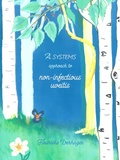A systems approach to non-infectious uveitis

Verhagen, Fleurieke
- Promoter:
- Prof.dr. J.H. (Joke) de Boer & Prof.dr. T.R.D.J. (Timothy) Radstake
- Co-promoter:
- Dr. J.J.W. (Jonas) Kuiper
- Research group:
- Radstake , Boer Kuiper
- Date:
- December 6, 2018
- Time:
- 12:45 h
Summary
Non-infectious uveitis (NIU) refers to a group of intraocular inflammatory conditions with great variability in disease course, visual prognosis, and treatment response. This inter-patient variability poses a challenge to find the right therapeutic approach for an individual patient. Also, as current therapies come with heavy side effects and fail to control NIU in up to 40% of all patients, there is a high need for new and more effective therapies. Ideally, such strategies will become more patient tailored (i.e. ‘personalized medicine’), taking clinical, personal, and molecular factors into account. To improve our understanding of this disease and pave the way for personalized medicine, we studied NIU using a systems approach, including clinical and molecular aspects as well as studying the personal impact of the disease on quality of life.
In chapter 2 we found that (peri) ocular pain is a relevant complaint of NIU patients, that is not exclusive to anterior uveitis patients, and that ocular pain has an impact on quality of life, most importantly, work related quality of life.
In chapter 3 we studied the incidence and causes of permanent visual impairment and blindness caused by HLA-B27 associated anterior uveitis and found that, after a median of 10 years follow-up, 9% of the 212 patients suffered from irreversible visual impairment or blindness in at least one eye. In 1% this vision loss was bilateral. We found secondary glaucoma to be the most common cause for vision loss. Risk factors in our study were ocular hypertension, hypotony, and progression to panuveitis. Considering these results we strongly recommend to closely monitor intraocular pressure, especially after commencing treatment with topical or periocular steroids.
In chapter 4 we studied the course of HLA-B27 associated acute anterior uveitis during pregnancy. Our results show that the risk of recurrence decreases during pregnancy to around 20% of the risk outside pregnancy. Although the adjustment of the therapy during pregnancy is dependent on multiple factors these results might aid the physician in the decision process.
In chapter 5, we studied the metabolic profiles of the aqueous humor (AqH) of patients with HLA-B27 positive and negative acute anterior uveitis. We observed several changes in the metabolic profile including branched-chain amino acid (BCAA) metabolism (higher in HLA-B27+ patients), ascorbate (vitamin C) and aldarate metabolism (lower in HLA-B27+ patients) and a disruption of the tricarboxylic acid (TCA) cycle. More specifically, we identified ketoleucine to be consistently upregulated in HLA-B27 positive anterior uveitis, and this metabolite correlated with disease activity.
In chapter 6 we describe the immune profiling of a patient with CRB1 related retinal dystrophy that was masquerading as intermediate uveitis.
In order to better understand pathways underlying NIU and find molecular clues to serve as biomarkers for clinically relevant outcomes or potential therapeutic targets, we applied several high-throughput techniques to immunophenotype the blood of patients with one of three subtypes of non-infectious uveitis: HLA-B27 associated acute anterior uveitis (in this thesis referred to as AU), idiopathic intermediate uveitis (in this thesis referred to as IU), and Birdshot uveitis (in this thesis referred to as BU), each representing a different primary site of inflammation (e.g., anterior uveitis, intermediate uveitis and posterior uveitis). The combined results of the chapters 7-9 support a strong involvement of multiple layers of the immune system, including microRNAs (chapter 7), T cells (chapter 8) and CD1c+ mDCs (chapter 9) in the pathogenesis of adult non-infectious uveitis.
In chapter 7 we describe the systematic identification and replication of a cluster of microRNAs (miRNAs) that was elevated in the serum of non-infectious uveitis patients. Our observations support the theory that these microRNAs act as a cluster, targeting genes involved in inflammation but also eye-related pathways.
In chapter 8 we conducted an immune-phenotyping study of mononuclear blood cells of the first cohort of non-infectious uveitis patients using flow cytometry. The overall changes in relative abundance of leukocyte subsets were modest, but several profound changes were found in the T cell compartment. In humans, multiple lines of evidence have linked type 17 immune responses and IL-17-producing T cells (‘Th17’ cells) to NIU. In line with this, we observed an increase of (CCR6+CXCR3-) Th17 cells within memory (CD45RO+) CD4 T cells (CD4 TM) that was noticeable for all uveitis types. Interestingly, we observed that the proportion of these cells was higher in patients that later needed IMT.
Despite the existence of many studies investigating the role of T cells in the pathogenesis of NIU, it is as yet unknown where and through which signals these T cells are activated. In chapter 9 we investigated the gene expression profile of CD1c+ myeloid dendritic cells in two independent cohorts and found, through a combination of computational analyses, a gene signature of 147 co-expressed genes that showed altered gene expression levels in non-infectious uveitis patients. This cluster included higher levels of many pattern recognition receptors and chemokine receptors, making these cells highly perceptive for secondary stimuli and supporting the hypothesis of a “hypersensitive” state. Future efforts should be made to functionally validate the exact function of the here identified key-genes in this process, to see whether targeting (transcription of) these genes might hold therapeutic potential.